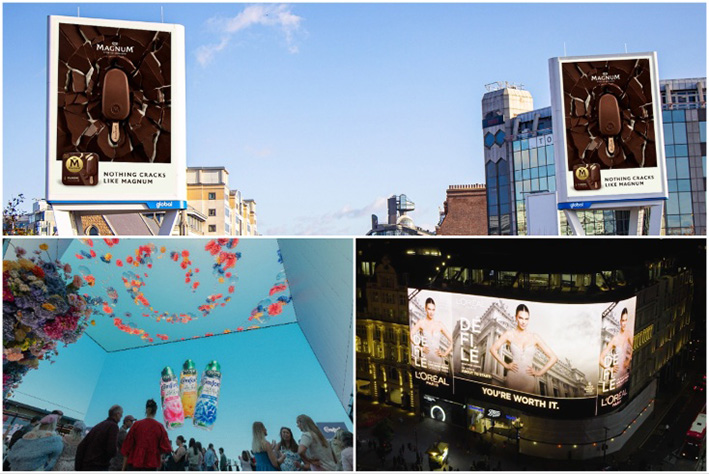Opinion
OOH is now more a performance than a poster and changing the way we think about public spaces. This real-world presence builds real connections.
One of the first OOH campaigns that really stuck with me was Nike’s “Run London”. It was the brand’s first 10km race, pitting north against south.
What made it so effective was the combination of clever placement — taking over the majority of formats across London — and bespoke creative that truly stood out. The messaging north of the river supported northern runners, while the south had its own tailored encouragement.
It was a brilliant example of public messaging used to drive excitement and build a real sense of occasion.
It’s often said that OOH is the oldest form of advertising and you only have to look at some of the most iconic campaigns to understand why it still holds so much power. From Araldite’s superglued cars to Marmite’s exploding lids, OOH has always known how to make a statement.
While so much has changed in media since then, OOH’s ability to grab attention and create emotional connection hasn’t. In fact, it’s only getting stronger.
An evolving channel
You see it every day on your commute. But what’s exciting now is how much it has moved on.
It’s no longer just static posters. OOH is evolving. It’s becoming digital, dynamic and interactive in ways that are changing how we think about public space.
Thanks to advanced technology, OOH has become digital, dynamic and even a bit dramatic. There are screens that change depending on the weather. Ads that only appear when a certain number of people are nearby. Campaigns that speak to you — quite literally — through sound, scent or even interaction.
When you’ve been on your feet for a few hours, browsing through shopping centres, is there anything more exciting than hearing the sound of chocolate cracking? What about if the audio doesn’t come from a physical chocolate bar, but from an ad — playing out loud from a billboard?
It may sound strange, since traditional OOH is typically silent, but that’s exactly what Magnum did for its latest campaign, “Nothing Cracks Like a Magnum”.
The campaign leverages Global’s API data feed to synchronise radio and digital OOH (DOOH) advertising. By syncing Magnum’s DOOH with what was playing on the radio, shoppers listening to Heart and driving past one of the participating screens simultaneously saw and heard the ad.
In certain locations, such as Westfield and Manchester’s Printworks, the sound played directly from the billboard itself.
The campaign felt more like a performance than a poster — sound, sight and timing all working together to give you a little jolt of joy. And maybe a sudden craving for ice-cream.
But this wasn’t just a gimmick; it’s a sign of where OOH advertising is heading. More importantly, it’s tangible evidence as to why it’s reclaiming its place as one of the most exciting and important spaces in media.
Screens that think, ads that you feel
It’s not just about grabbing attention any more. It’s about creating real-world moments that you actually remember.
Which is why DOOH is growing faster than any traditional media channel in the UK. Because it delivers something digital alone can’t: a shared, sensory experience.
We’re all drowning in the digital-first world. The average adult in the UK spends more than four hours online every day. The noise is constant — whether it’s notifications, pop-ups, autoplay videos or infinite scrolling through our countless social media feeds.
No wonder people are craving the opposite. Something physical and real. Something they can see, hear, maybe even smell — and, crucially, share in the real world with others.
That’s where OOH comes in. It doesn’t disrupt your day; it’s part of it. OOH is public, trusted and can be surprisingly powerful when it plays with your senses.
Take Netflix’s sweating billboard. This installation’s success stemmed from its ability to surprise people and tap into their senses. In a world of digital fatigue, moments like these really matter.
When OOH ads become experiences
There’s a reason the “experience economy” is booming. People want to do things, not just buy things.
Advertisers are waking up to the fact that real-world presence builds real connections. That’s why we’re seeing more immersive OOH campaigns; notable examples include Comfort’s scented flower show at Outernet or L’Oréal turning Piccadilly Circus into a beauty playground.
These aren’t just ads; they’re events that people actively seek out and show up to — demonstrating OOH’s ability to create unique, shareable experiences that resonate with audiences on a deeper level.
But the real power of OOH today isn’t just creativity or tech. It’s context.
We now have the tools to better understand consumers outside the home — through smart, aggregated mobile and fully GDPR-compliant behavioural data. This means we now have a richer understanding of where groups of people are, at what time and how they may be feeling, allowing us to deliver more personalised ads at scale.
An ad outside the gym lands differently at 6am than it does at 6pm. A poster near the supermarket hits harder when it reflects what’s on offer inside. A screen in the shopping centre can react in real time to stock levels, weather or even how busy it is.
That kind of real-world relevance, powered by data, delivered in the moment, is what makes DOOH a clever part of the media mix.
It’s not just another channel. It’s the connective tissue between the digital world and the real one.
Bigger picture
For brands, this means it’s time to think bigger and bolder. DOOH has become a stage, rather than a backdrop. The brands that are using it well aren’t just advertising — they’re performing.
In a media landscape dominated by algorithms and hyper-targeting online, DOOH is carving out a space for real-world creativity, storytelling and shared experiences. Brands that create work that are designed to be noticed, felt and talked about will truly cut through and create lasting impressions.
It’s not just about more tech, but using it better to create smarter campaigns. More sensory moments that make people feel something. The sound of the cracking chocolate may seem like a small thing, but it’s a powerful reminder of what great advertising can do.
The best bit is: we’ve only just cracked the surface.
 Nicole Lonsdale is chief client officer at GroupM OOH
Nicole Lonsdale is chief client officer at GroupM OOH
Adwanted UK is the trusted delivery partner for three essential services which deliver accountability, standardisation, and audience data for the out-of-home industry.
Playout is Outsmart’s new system to centralise and standardise playout reporting data across all outdoor media owners in the UK.
SPACE is the industry’s comprehensive inventory database delivered through a collaboration between IPAO and Outsmart.
The RouteAPI is a SaaS solution which delivers the ooh industry’s audience data quickly and simply into clients’ systems.
Contact us for more information on SPACE, J-ET, Audiotrack or our data engines.






 Nicole Lonsdale is chief client officer at GroupM OOH
Nicole Lonsdale is chief client officer at GroupM OOH